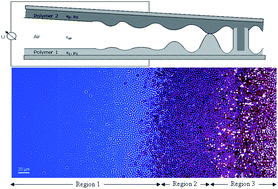Pattern formation induced by an electric field in a polymer–air–polymer thin film system†
Abstract
Strong electric fields produce forces that can overcome the surface tension in thin liquid

* Corresponding authors
a
Department of Physics & Energy, University of Limerick, Ireland
E-mail:
george.amarandei@ul.ie
Fax: +353 61 202423
Tel: +353 61 202625
b Département de Physique, Université d'Avignon & INRA, UMR1114 EMMAH, F-84914 Avignon, France
c Department of Physics, University of Cambridge, Cavendish Laboratory, JJ Thomson Avenue, Cambridge, UK
d Department of Mathematical Sciences, Loughborough University, Loughborough, Leicestershire, UK
Strong electric fields produce forces that can overcome the surface tension in thin liquid

 Please wait while we load your content...
Something went wrong. Try again?
Please wait while we load your content...
Something went wrong. Try again?
G. Amarandei, P. Beltrame, I. Clancy, C. O'Dwyer, A. Arshak, U. Steiner, D. Corcoran and U. Thiele, Soft Matter, 2012, 8, 6333 DOI: 10.1039/C2SM25273B
To request permission to reproduce material from this article, please go to the Copyright Clearance Center request page.
If you are an author contributing to an RSC publication, you do not need to request permission provided correct acknowledgement is given.
If you are the author of this article, you do not need to request permission to reproduce figures and diagrams provided correct acknowledgement is given. If you want to reproduce the whole article in a third-party publication (excluding your thesis/dissertation for which permission is not required) please go to the Copyright Clearance Center request page.
Read more about how to correctly acknowledge RSC content.
 Fetching data from CrossRef.
Fetching data from CrossRef.
This may take some time to load.
Loading related content
